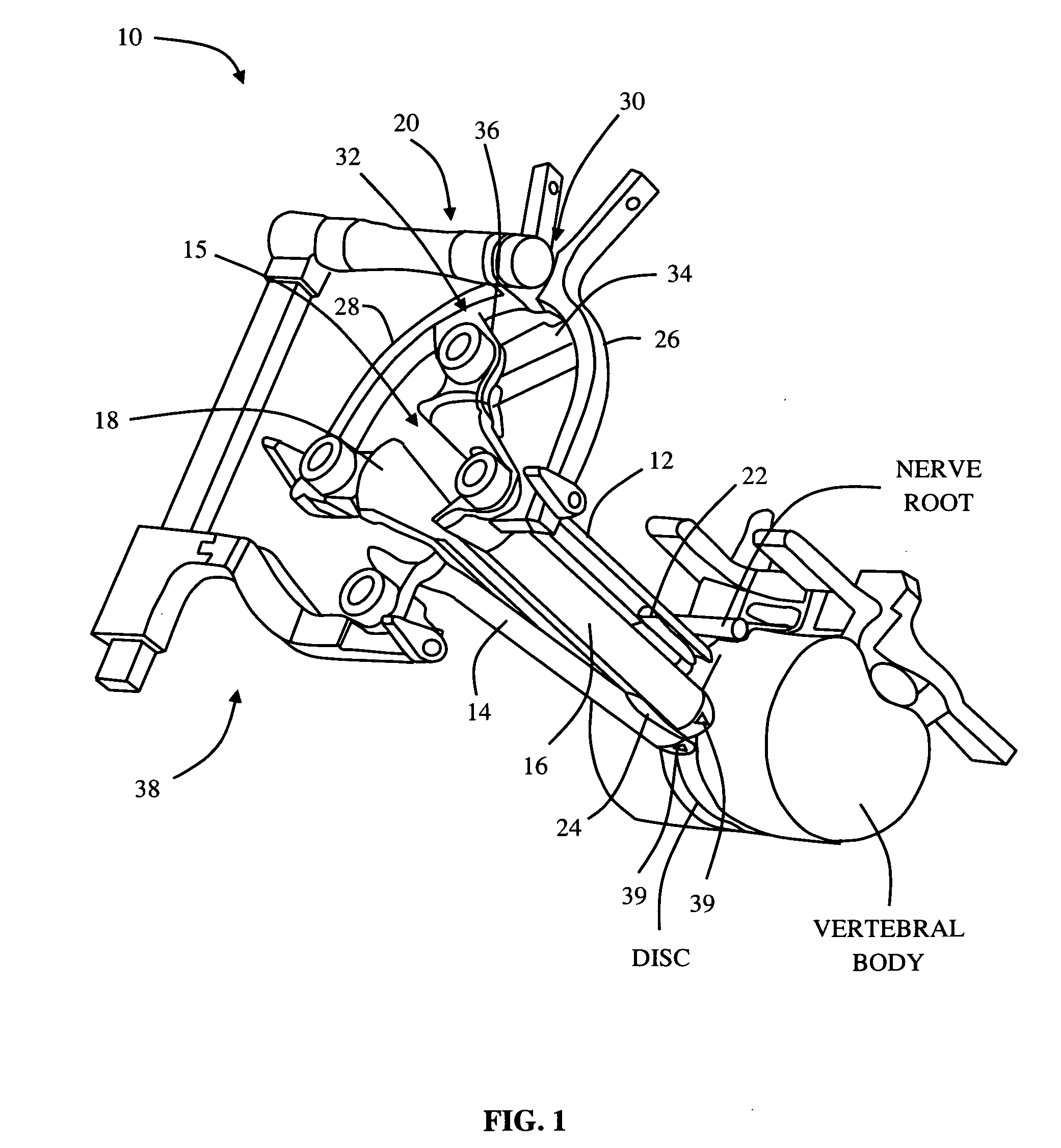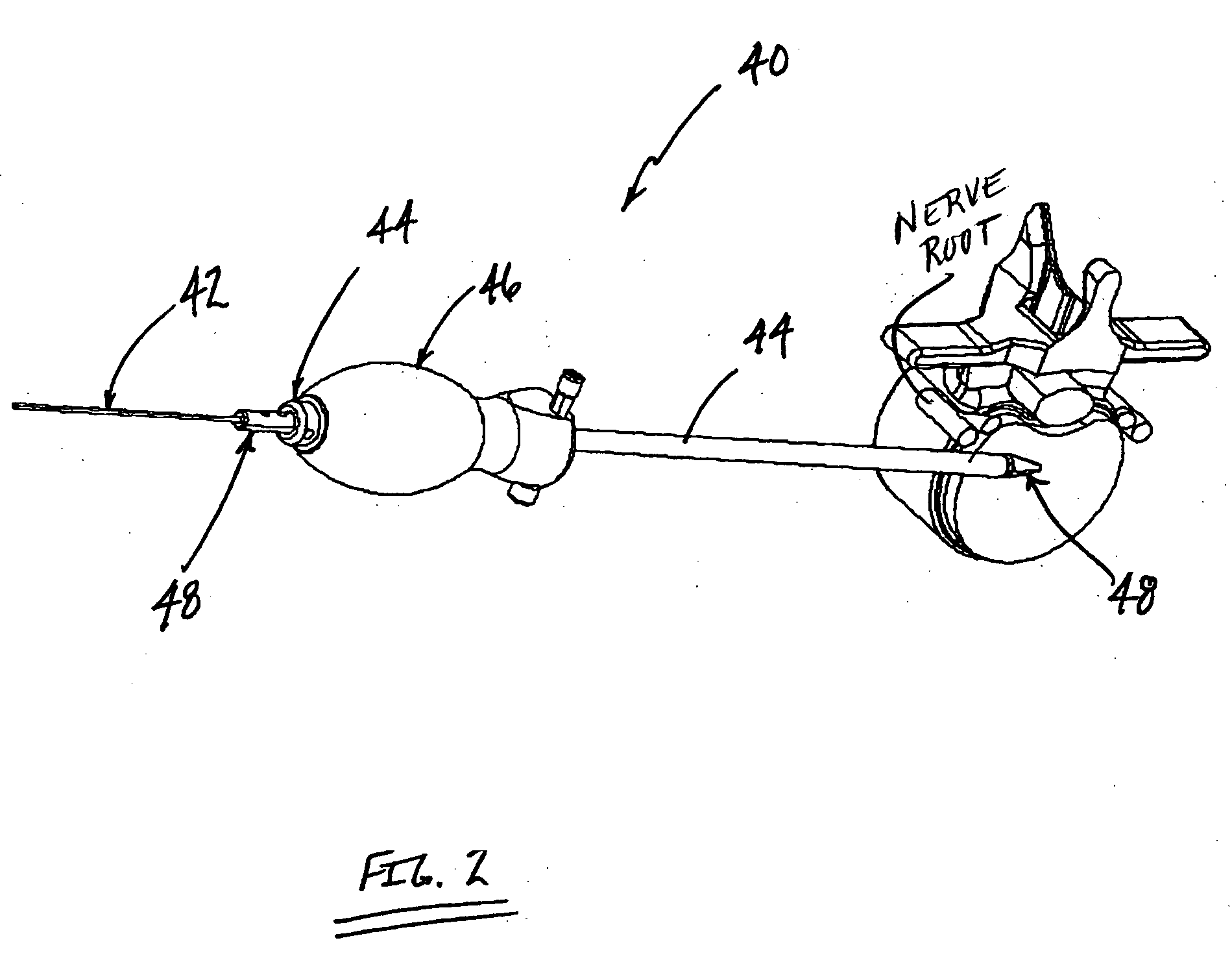[0015]This monitoring may be accomplished via any number of suitable fashions, including but not limited to observing visual twitches in
muscle groups associated with the neural structures likely to found in the tissue, as well as any number of monitoring systems. In either situation (traditional EMG or surgeon-driven EMG monitoring), the access system of the present invention may advantageously be used to
traverse tissue that would ordinarily be deemed unsafe or undesirable, thereby broadening the number of manners in which a given surgical target site may be accessed.
[0016]The tissue
distraction assembly is capable of, as an initial step, distracting a region of tissue between the
skin of the patient and the surgical target site. The tissue retraction assembly is capable of, as a secondary step, being introduced into this distracted region to thereby define and establish the operative corridor. Once established, any of a variety of surgical instruments, devices, or implants may be passed through and / or manipulated within the operative corridor depending upon the given surgical procedure. The
electrode(s) are capable of, during both tissue
distraction and retraction, detecting the existence of (and optionally the distance and / or direction to) neural structures such that the operative corridor may be established through (or near) any of a variety of tissues having such neural structures which, if contacted or impinged, may otherwise result in neural impairment for the patient. In this fashion, the access system of the present invention may be used to
traverse tissue that would ordinarily be deemed unsafe or undesirable, thereby broadening the number of manners in which a given surgical target site may be accessed.
[0018]The tissue retraction assembly may include any number of components capable of performing the necessary retraction. By way of example only, the tissue retraction assembly may include one or more
retractor blades extending proximally from the surgical target site for connection with a pivot linkage assembly. The pivot linkage includes first and second pivot arms capable of maintaining the
retractor blades in a first, closed position to facilitate the introduction of the
retractor blades over the distraction assembly. Thereafter, the pivot linkage may be manipulated to open the retractor assembly; that is, allowing the retractor blades to separate from one another (preferably simultaneously) to create an operative corridor to the surgical target site. In a preferred embodiment, this is accomplished by maintaining a posterior
retractor blade in a
fixed position relative to the surgical target site (so as to avoid having it impinge upon any exiting nerve roots near the posterior elements of the spine) while the additional retractor blades (i.e. cephalad, caudal and / or anterior retractor blades) are moved or otherwise translated away from the posterior
retractor blade (and each other) so as to create the operative corridor in a fashion that doesn't infringe upon the region of the exiting nerve roots. This is accomplished, in part, through the use of a secondary pivot linkage coupled to the pivot linkage assembly, which allows the posterior
retractor blade to remain in a constant position while the other retractor blades are moved. In one embodiment, the anterior retractor blade may be positioned after the posterior, cephalad, and caudal retractor blades are positioned into the fully retracted position. This may be accomplished by
coupling the anterior retractor blade to the pivot linkage via an arm assembly.
[0019]The retractor blades may be optionally dimensioned to receive and direct a rigid shim element to augment the
structural stability of the retractor blades and thereby ensure the operative corridor, once established, will not decrease or become more restricted, such as may result if distal ends of the retractor blades were permitted to “slide” or otherwise move in response to the force exerted by the displaced tissue. In a preferred embodiment, only the posterior and anterior retractor blades are equipped with such rigid shim elements, which are advanced into the
disc space after the posterior and anterior retractor blades are positioned (posterior first, followed by anterior after the cephalad, caudal and anterior blades are moved into the fully retracted position). The rigid shim elements are preferably oriented within the
disc space such that they distract the adjacent vertebral bodies, which serves to restore
disc height. They are also preferably advanced a sufficient distance within the
disc space (preferably past the midline), which serves the
dual purpose of preventing post-operative
scoliosis and forming a
protective barrier (preventing the migration of tissue (such as nerve roots) into the operative field and the inadvertent advancement of instruments outside the operative field).
[0020]The retractor blades may optionally be equipped with a mechanism for transporting or emitting light at or near the surgical target site to aid the surgeon's ability to visualize the surgical target site, instruments and / or implants during the given surgical procedure. According to one embodiment, this mechanism may comprise, but need not be limited to, providing one or more strands of
fiber optic cable within the walls of the retractor blades such that the terminal (distal) ends are capable of emitting light at or near the surgical target site. According to another embodiment, this mechanism may comprise, but need not be limited to, constructing the retractor blades of suitable material (such as clear
polycarbonate) and configuration such that light may be transmitted generally distally through the walls of the retractor blade light to shine light at or near the surgical target site. This may be performed by providing the retractor blades having light-transmission characteristics (such as with clear
polycarbonate construction) and transmitting the light almost entirely within the walls of the retractor blade (such as by frosting or otherwise rendering opaque portions of the exterior and / or interior) until it exits a portion along the interior (or medially-facing) surface of the retractor blade to shine at or near the surgical target site. The exit portion may be optimally configured such that the light is directed towards the approximate center of the surgical target site and may be provided along the entire inner periphery of the retractor blade or one or more portions therealong.
 Login to View More
Login to View More  Login to View More
Login to View More 


